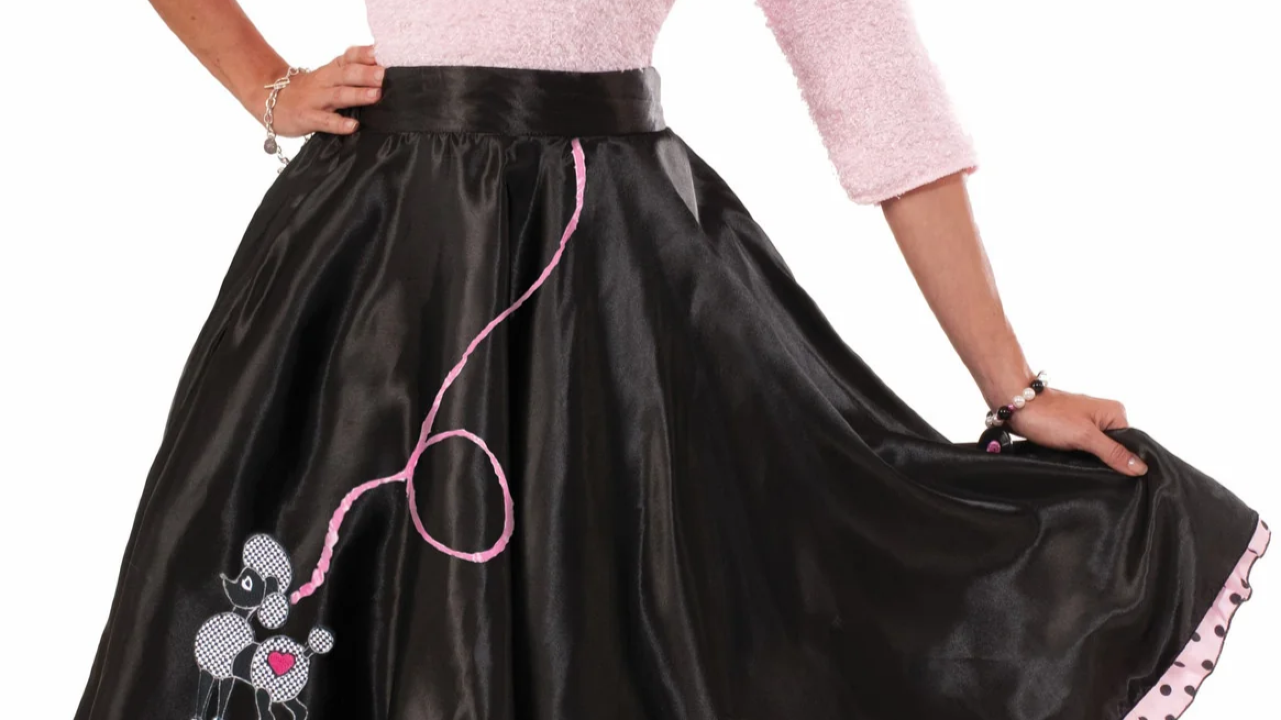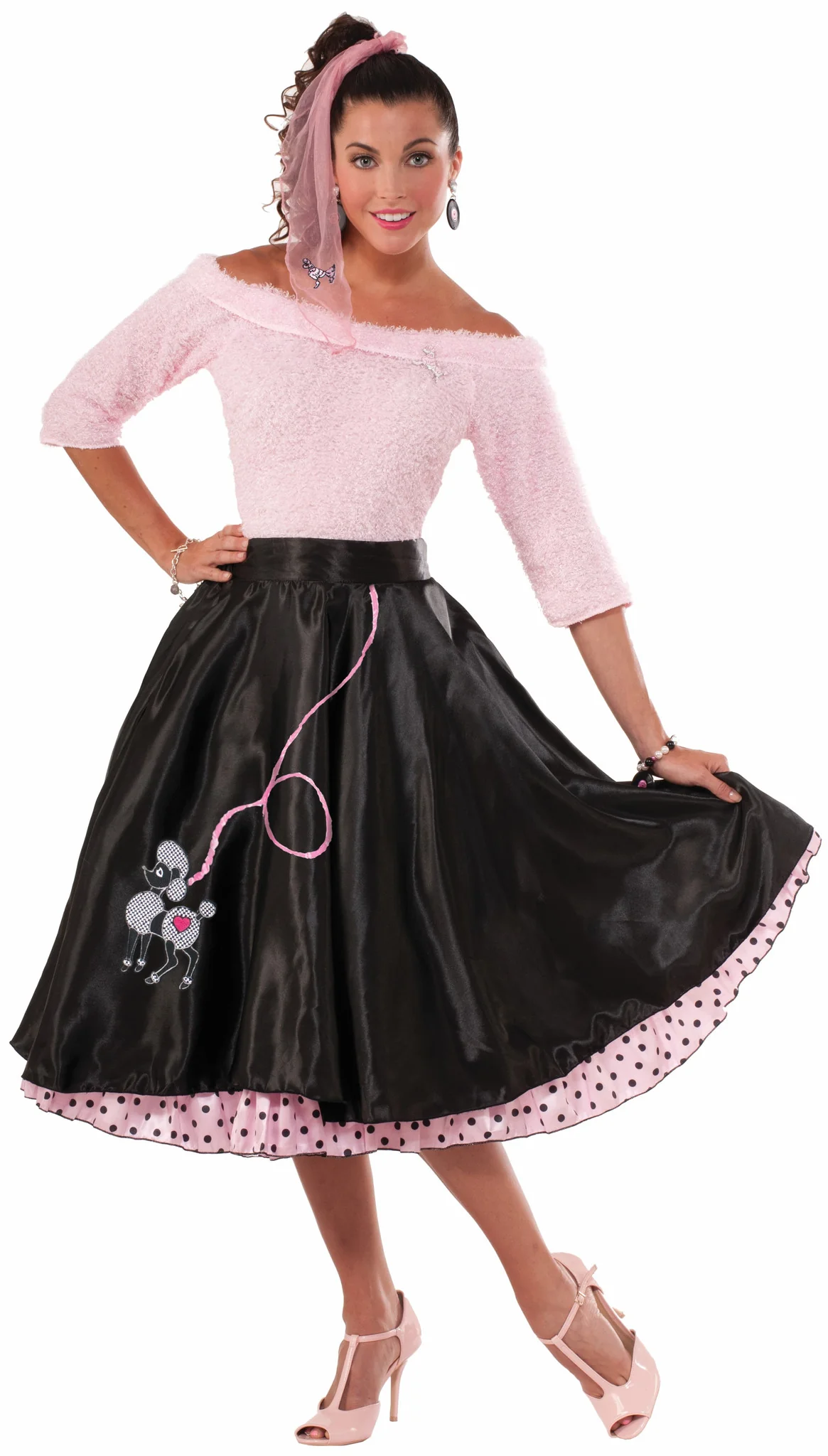AllVintageStyles
Vintage fashion encyclopedia
Poodle Skirt


A 1950s poodle skirt is a felt circle skirt featuring appliqué designs, most famously poodles, that became an iconic symbol of teenage fashion and American youth culture during the post-war era.
Quick Facts
- Era: 1950s (peak popularity 1954-1958)
- Origin: United States (created by Juli Lynne Charlot in 1947)
- Garment Type: Circle skirt with appliqué decoration
- Key Identifiers: Felt fabric, poodle appliqué, circle skirt construction, knee-length
- Typical Resale Price: $75-$250 (authentic vintage pieces)
- Best For: Rockabilly enthusiasts, 1950s sock hop events, and vintage dance occasions
History & Evolution
The poodle skirt was invented in 1947 by fashion designer Juli Lynne Charlot, who needed a last-minute Christmas party outfit and created a felt circle skirt with an appliqué poodle design. The style quickly caught on among teenage girls who embraced the playful, youthful aesthetic that contrasted with their mothers' more formal attire.
The skirt became synonymous with 1950s teenage culture, worn to sock hops, drive-ins, and high school social events. While poodles were the most famous design, skirts featured various appliqués including musical notes, telephones, cars, and other symbols of 1950s pop culture. The style represented teenage independence and the emergence of youth as a distinct consumer market.
By the late 1950s, the poodle skirt had become somewhat dated as fashion moved toward more sophisticated silhouettes. However, the design gained permanent status as an icon of 1950s Americana, frequently revived for costume events and vintage fashion. Today, authentic vintage poodle skirts are treasured by collectors as quintessential examples of post-war American youth culture.
Authentication Tips
Authentic 1950s Features:
- High-quality wool felt construction with substantial weight
- Hand-applied or machine-applied appliqué with quality stitching
- Circle skirt construction cut from full fabric panels
- Side or back metal zipper with period-appropriate hardware
- 1950s sizing and proportions designed for petticoats
Common Reproductions/Modern Pieces:
- Cheap synthetic felt or costume-quality materials
- Poorly applied appliqués with visible glue or cheap stitching
- Gathered skirts instead of true circle construction
- Modern plastic zippers or contemporary closure methods
- Contemporary sizing that doesn't accommodate vintage undergarments
Styling & Use Cases
- Best for rockabilly enthusiasts: Pair with fitted cardigans, saddle shoes, and bobby socks for authentic 1950s teenage styling
- Ideal for themed events: Style with ponytails, headbands, and vintage accessories for sock hop or costume parties
- Perfect for vintage dancers: Combine with petticoats and comfortable shoes for swing dancing and lindy hop events
Modern styling tips:
- Wear with fitted contemporary tops and minimal petticoats for casual vintage-inspired looks
- Pair with denim jackets or modern blazers to blend vintage and contemporary elements
- Style with modern sneakers or flats for comfortable everyday vintage wearing
FAQ
Q: How can I tell if a poodle skirt is authentic 1950s vintage?
A: Look for high-quality wool felt construction, hand or machine-applied appliqués with quality stitching, circle skirt construction, and metal zippers. Authentic pieces show the substantial felt weight and construction methods typical of 1950s garment manufacturing.
Q: What's the typical price range for vintage poodle skirts?
A: Authentic vintage poodle skirts range from $75-$250 depending on condition, rarity of appliqué design, and overall quality. Exceptional examples or rare designs command higher prices among 1950s fashion collectors.
Q: How should I care for a vintage poodle skirt?
A: Dry clean only to preserve the felt fabric and appliqué details. Store hanging or flat with acid-free tissue paper to prevent creasing and protect the appliqué work from damage.
Q: What makes poodle skirts valuable to collectors?
A: Their representation of 1950s teenage culture, association with American post-war optimism, iconic status in fashion history, and embodiment of youth consumer culture make them significant pieces for vintage Americana collectors.
📷: HornerNovelty
